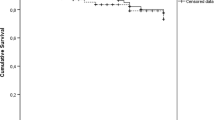Abstract
Mycobacterium xenopi pulmonary disease (Mxe-PD) is common among nontuberculous mycobacterial infections in Europe and Canada. Associations between radiological pattern and clinical features and outcomes are inadequately studied in Mxe-PD. We sought to investigate clinical characteristics and outcomes according to the dominant radiological pattern among patients with Mxe-PD. We retrospectively studied patients with Mxe-PD seen in our clinic, categorizing their predominant CT pattern as nodular bronchiectasis, fibrocavitary, or unclassifiable, and compared clinical characteristics, treatment, and outcomes between radiologic groups. Of 94 patients with Mxe-PD, CT patterns comprised nodular bronchiectasis (40/94, 42.6%), fibrocavitary (37/94, 39.4%), and unclassifiable (17/94, 18.1%). Compared with fibrocavitation, patients with nodular bronchiectasis were female dominant, less often had COPD, less often had AFB smear-positive sputum, and more frequently had co-isolation of Pseudomonas. Patients with nodular bronchiectasis were less often treated (65% versus 91.9%) and when treated, they received fewer anti-mycobacterial drugs (on average 3 versus 4). Outcomes did not differ significantly by radiological pattern. Nodular bronchiectasis was common among Mxe-PD patients in our clinic. Compared with fibrocavitary disease, patients with nodular bronchiectasis had features suggestive of milder disease and were less often treated. Among treated patients, outcomes did not differ by radiologic pattern.


Similar content being viewed by others
References
Prevots DR, Marras TK (2015) Epidemiology of human pulmonary infection with nontuberculous mycobacteria: a review. Clin Chest Med 36:13–34. https://doi.org/10.1016/j.ccm.2014.10.002
Marras TK, Mendelson D, Marchand-Austin A et al (2013) Pulmonary nontuberculous mycobacterial disease, Ontario, Canada, 1998-2010. Emerg Infect Dis 19:1889–1891. https://doi.org/10.3201/eid1911.130737
Hoefsloot W, Van Ingen J, Andrejak C et al (2013) The geographic diversity of nontuberculous mycobacteria isolated from pulmonary samples: an NTM-NET collaborative study. Eur Respir J 42:1604–1613. https://doi.org/10.1183/09031936.00149212
van Ingen J, Boeree MJ, de Lange WCM et al (2008) Mycobacterium xenopi clinical relevance and determinants, the Netherlands. Emerg Infect Dis 14:385–389. https://doi.org/10.3201/eid1403.061393
Andrejak C, Lescure F-X, Pukenyte E et al (2009) Mycobacterium xenopi pulmonary infections: a multicentric retrospective study of 136 cases in north-east France. Thorax 64:291–296. https://doi.org/10.1136/thx.2008.096842
Griffith DE, Aksamit T, Brown-Elliott BA et al (2007) An official ATS/IDSA statement: diagnosis, treatment, and prevention of nontuberculous mycobacterial diseases. Am J Respir Crit Care Med 175:367–416. https://doi.org/10.1164/rccm.200604-571ST
Hayashi M, Takayanagi N, Kanauchi T et al (2012) Prognostic factors of 634 HIV-negative patients with Mycobacterium avium complex lung disease. Am J Respir Crit Care Med 185:575–583. https://doi.org/10.1164/rccm.201107-1203OC
Ito Y, Hirai T, Maekawa K et al (2012) Predictors of 5-year mortality in pulmonary Mycobacterium avium-intracellulare complex disease. Int J Tuberc Lung Dis 16:408–414. https://doi.org/10.5588/ijtld.11.0148
Hirama T, Marchand-Austin A, Ma J et al (2018) Mycobacterium xenopi genotype associated with clinical phenotype in lung disease. Lung 196:213–217. https://doi.org/10.1007/s00408-018-0087-9
Hirama T, Brode SK, Beswick J et al (2018) Characteristics, treatment and outcomes of nontuberculous mycobacterial pulmonary disease after allogeneic hematopoietic stem cell transplant. Eur Respir J 51:1702330. https://doi.org/10.1183/13993003.02330-2017
Lam PK, Griffith DE, Aksamit TR et al (2006) Factors related to response to intermittent treatment of Mycobacterium avium complex lung disease. Am J Respir Crit Care Med 173:1283–1289. https://doi.org/10.1164/rccm.200509-1531OC
van Ingen J, Aksamit T, Andrejak C et al (2018) Treatment outcome definitions in nontuberculous mycobacterial pulmonary disease: an NTM-NET consensus statement. Eur Respir J 51:1800170. https://doi.org/10.1183/13993003.00170-2018
Marras TK, Wagnetz U, Jamieson FB, Patsios DA (2013) Chest computed tomography predicts microbiological burden and symptoms in pulmonary Mycobacterium xenopi. Respirology 18:92–101. https://doi.org/10.1111/j.1440-1843.2012.02277.x
Carrillo MC, Patsios D, Wagnetz U et al (2014) Comparison of the spectrum of radiologic and clinical manifestations of pulmonary disease caused by mycobacterium avium complex and mycobacterium xenopi. Can Assoc Radiol J 65:207–213. https://doi.org/10.1016/j.carj.2013.05.006
Park SW, Song JW, Shim TS et al (2012) Mycobacterial pulmonary infections in patients with idiopathic pulmonary fibrosis. J Korean Med Sci 27:896–900. https://doi.org/10.3346/jkms.2012.27.8.896
Jo K-W, Kim S, Lee JY et al (2014) Treatment outcomes of refractory MAC pulmonary disease treated with drugs with unclear efficacy. J Infect Chemother 20:602–606. https://doi.org/10.1016/j.jiac.2014.05.010
Varadi RG, Marras TK (2009) Pulmonary Mycobacterium xenopi infection in non-HIV-infected patients: a systematic review. Int J Tuberc Lung Dis 13:1210–1218
Wallace RJ, Brown-Elliott BA, McNulty S et al (2014) Macrolide/azalide therapy for nodular/bronchiectatic Mycobacterium avium complex lung disease. Chest 146:276–282. https://doi.org/10.1378/chest.13-2538
Koh W-J, Moon SM, Kim S-Y et al (2017) Outcomes of Mycobacterium avium complex lung disease based on clinical phenotype. Eur Respir J 50:1602503. https://doi.org/10.1183/13993003.02503-2016
Haworth CS, Banks J, Capstick T et al (2017) British Thoracic Society guidelines for the management of non-tuberculous mycobacterial pulmonary disease (NTM-PD). Thorax 72:ii1–ii64. https://doi.org/10.1136/thoraxjnl-2017-210927
Research Committee of the British Thoracic Society (2001) First randomised trial of treatments for pulmonary disease caused by M avium intracellulare, M malmoense, and M xenopi in HIV negative patients: rifampicin, ethambutol and isoniazid versus rifampicin and ethambutol. Thorax 56:167–172
Diel R, Ringshausen F, Richter E et al (2017) Microbiological and clinical outcomes of treating non-Mycobacterium avium complex nontuberculous mycobacterial pulmonary disease: a systematic review and meta-analysis. Chest 152:120–142. https://doi.org/10.1016/j.chest.2017.04.166
Acknowledgement
This work is supported in part by Kurozumi Medical Foundation and Tokyo-Hokenkai Byotai-Seiri Laboratory.
Author information
Authors and Affiliations
Corresponding author
Ethics declarations
Conflict of interest
The authors declare that they have no conflict of interest.
Ethical approval
The study protocol was reviewed by the University Health Network-Research Ethics Board (Research Ethics Board number 18-5104).
Informed consent
In light of the retrospective design, the requirement of informed consent was waived.
Additional information
Publisher’s note
Springer Nature remains neutral with regard to jurisdictionalclaims in published maps and institutional affiliations.
Rights and permissions
About this article
Cite this article
Hirama, T., Brode, S.K. & Marras, T.K. Radiologic types of Mycobacterium xenopi pulmonary disease: different patients with similar short-term outcomes. Eur J Clin Microbiol Infect Dis 38, 373–381 (2019). https://doi.org/10.1007/s10096-018-3437-x
Received:
Accepted:
Published:
Issue Date:
DOI: https://doi.org/10.1007/s10096-018-3437-x




